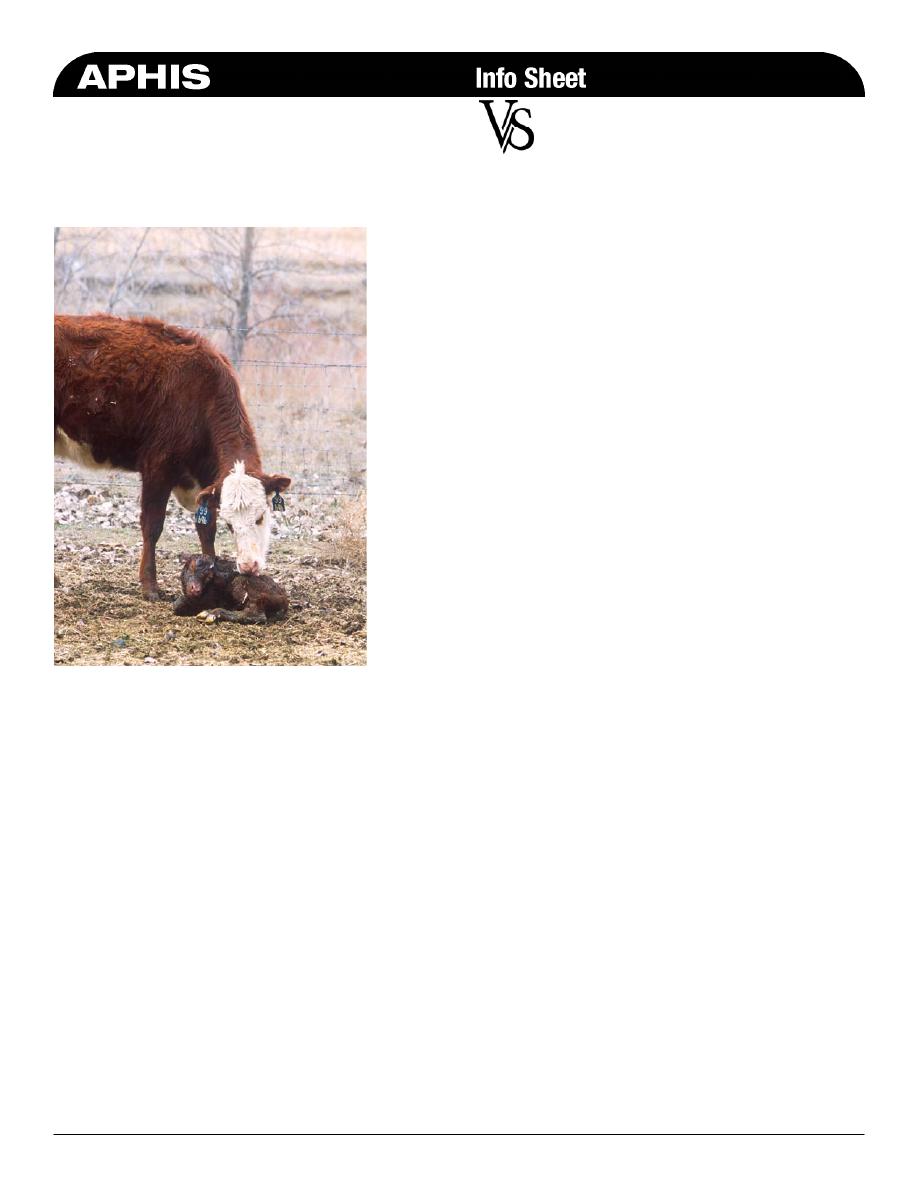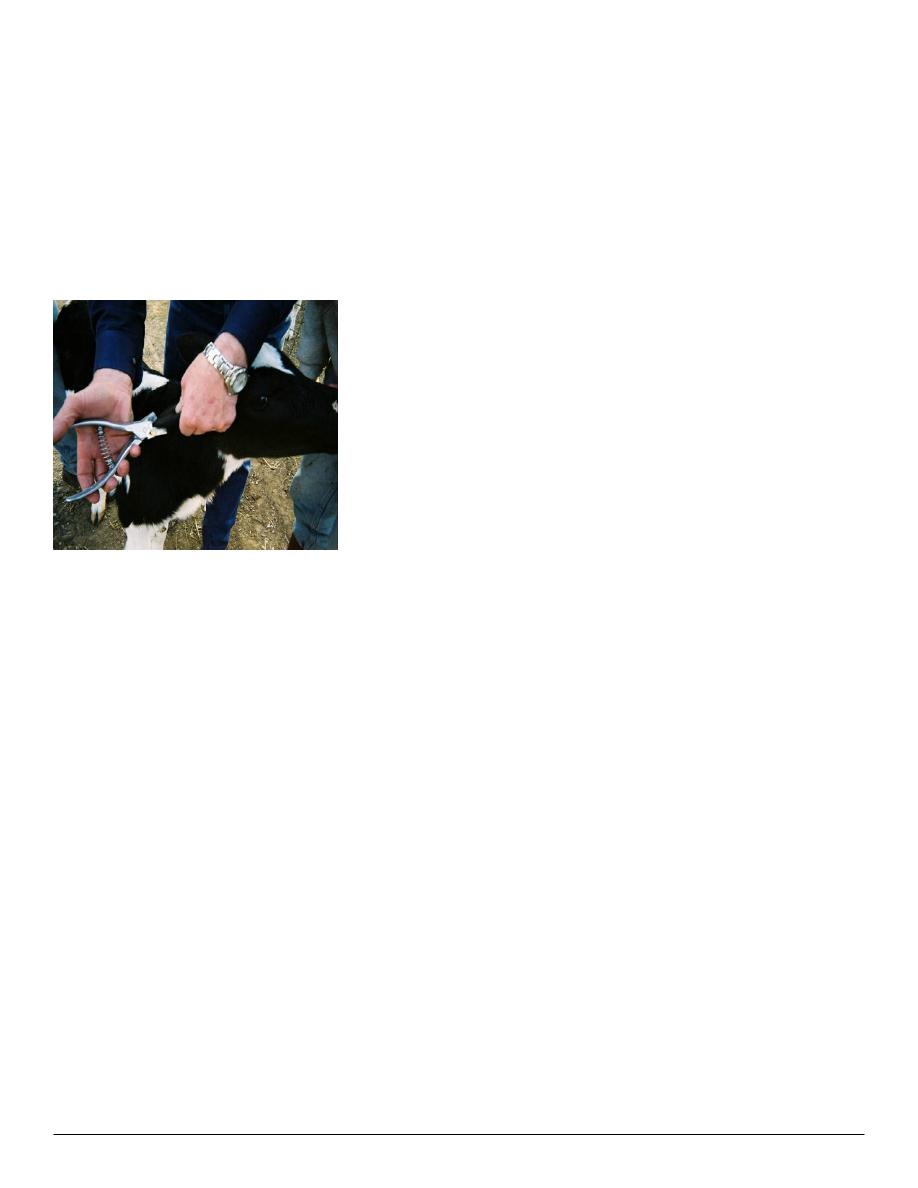
Veterinary Services
Centers
for
Epidemiology
and
Animal
Health
December
2007
_________________________________________________________________________________________________________________________
Bovine Viral Diarrhea Virus
Figure 1. Is this newborn calf infected with BVDV? (Photo
courtesy USDA:ARS Image Gallery).
What is bovine viral diarrhea?
Bovine viral diarrhea is a viral disease of cattle and
other ruminants that is caused by the bovine viral
diarrhea virus (BVDV). BVDV is a member of the
pestivirus genus. There are four recognized
species within the pestivirus genus. These species
are BVDV-1, BVDV-2, border disease virus of
sheep and classical swine fever virus, previously
known as hog cholera virus.
What are some signs that a herd may be
affected by BVDV?
The clinical signs of BVDV infection are highly
variable, including a spectrum from few to no signs
to very severe signs that kill the animal. The signs
can be determined by the genotype of the virus,
whether the infection was recently acquired (i.e.,
acute) or has been acquired for months (i.e.,
chronic), whether the animal is pregnant, as well as
other factors. Some of the signs of acute infection
are fever, lethargy, loss of appetite, ocular
discharge, nasal discharge, oral lesions, diarrhea,
and decreasing milk production. Chronic infection
may lead to signs of mucosal disease.
Generally, what are the most common
consequences of BVDV infection?
The most common consequences of BVDV
infection are respiratory and reproductive problems.
Problems due to BVDV-related reproductive
disorders may be the most important economically.
There is some evidence that suggests that the
losses due to BVDV in the United States are
increasing.
What is the most commonly recognized
birth defect caused by BVDV infection?
The most commonly recognized birth defect or
congenital defect is cerebellar hypoplasia. The
signs of cerebellar hypoplasia in newly born calves
are ataxia, tremors, wide stance, stumbling, and
failure to nurse. The defects are severe enough
that compensation will not occur, and the calves
may die.
Economically speaking, why should beef
producers be concerned about BVDV?
BVDV adversely affects both health and
productivity. The losses due to transient infection
are diarrhea, decreased milk production,
reproductive disorders, increased occurrence of
other diseases, and death. The losses from fetal
infection include abortions; congenital defects;
weak and abnormally small calves; unthrifty,
persistently infected (PI) animals; and death among
PI animals. During outbreaks of acute BVD, the
losses were estimated to be $50 to $100 per cow in
the herd. During outbreaks of severe acute BVD in
Canada around 1998, the losses were estimated to
be $40,000 to $100,000 per herd, or $400 per cow
in the herd.
Has the economic impact of BVDV been
assessed at a national level?
The impact has been assessed in Denmark and
Norway, but not in the United States. The cost of
BVDV in Denmark prior to its eradication program
was estimated to be $20 million per one million calf
births. The losses were estimated to be $57 million
United States Department of Agriculture • Animal and Plant Health Inspection Service
• Safeguarding American Agriculture

per one million calf births when the effects of
virulent strains were estimated. The economic loss
in Norway prior to its eradication program was
estimated to be $10 million per one million calf
births. The lower number corresponds to a lower
prevalence in Norway. In Canada, the total annual
cost for an average 50-cow dairy herd was
estimated around year 2002 to be $48 per cow.
Are there breeds of cattle that are more
susceptible than other breeds to BVDV
infection?
No. There is no information that suggests that
some breeds of cattle are more susceptible than
other breeds to BVDV infection.
What are risk factors for BVDV infections?
The risk factors for BVDV infections are often a
reflection of the risk of direct or indirect contact with
PI cattle. The suspected risk factors include
livestock trade, pasturing animals, use of common
pasture for infected and susceptible cattle, cattle
density, number of infected neighboring herds,
broken fences, animal contact between herds (e.g.,
livestock exhibitions), weak hygiene, and presence
of other susceptible ruminants, such as sheep and
wildlife. A goal of Beef 2007/2008, a national study
of the United States beef cow-calf industry, is to
more clearly define the risk factors for BVDV
infection.
How is BVDV transmitted?
BVDV transmission may occur vertically (i.e.,
before birth), leading to congenital infection of the
fetus, or the transmission may occur horizontally
(i.e., after birth). Congenital infections may cause
resorption, abortion, stillbirth, or live-birth.
Congenitally infected fetuses that survive in utero
infection (i.e., the live-births) may be born as
BVDV-infected calves. The BVDV infection in these
calves will persist during the entire life of the calf,
and they will shed BVDV continuously in the farm
environment.
Why is it important to prevent BVDV
infection in bulls?
Both acute and persistent infections may decrease
the reproductive soundness of bulls. The primary
affect of infection in bulls is the subsequent
potential for venereal transmission during breeding
and the shedding of BVDV in semen. Susceptible
cows may become infected following artificial
insemination with contaminated semen. The semen
from acutely infected bulls will pass a breeding
soundness examination, which will increase the risk
of transmission to susceptible cows. BVDV
infection was transmitted by a single bull to 55
cows in one herd and to several other herds that
had been free of BVDV.
Is there a way to certify that semen is free
of BVDV?
Yes. BVDV contamination of distributed semen is
prevented by practicing standardized testing and
quarantine procedures in AI semen collection
facilities. Certified Semen Services, Inc., or CSS, is
a cooperative in which membership ensures that
the standardized procedures are utilized
appropriately. Use of semen from CSS-certified
collections is recommended to prevent introduction
of BVDV via semen.
Can BVDV infect a fetus during late
gestation?
Fetuses infected during late gestation are
immunocompetent and capable of mounting an
effective immune response against BVDV.
However, the risk is greater that these calves will
experience a serious postnatal health hazard.
Calves born with BVDV-neutralizing antibodies, an
indicator that these calves had become infected
before birth, were twice as likely to experience a
severe illness during the first 10 months of life,
when compared to calves born without BVDV-
neutralizing antibodies.
Does BVDV infection affect the fetus
differently at different stages of gestation?
Transmission of BVDV to the fetus at 30 to 45 days
of gestation decreases conception rates and the
viability of the embryo. Fetuses that become
infected from 30 to 125 days of gestation and
survive the infection will be born as BVDV-infected
calves. The BVDV infection will persist for the life of
the calf, hence the term “persistent infection,” or PI.
Transmission of BVDV to the fetus after 120 to 150
days of gestation may result in abortion, stillbirth,
congenital defects, or birth of a live, normal-
appearing calf. Congenital anomalies are the most
frequent outcome of infections that occur during
days 125 to 175 of gestation. Fetuses that become
infected after 175 days are more resistant to
infection because they are immunocompetent;
however, these fetuses are more likely to
experience a serious health problem during the first
10 months of life.
How does a fetus become a PI fetus?
A PI animal acquires BVDV infection in utero before
its immune system becomes functional. The fetus is
not immunocompetent at the time of infection; thus,
it cannot offer resistance to the BVDV that caused
United States Department of Agriculture • Animal and Plant Health Inspection Service
• Safeguarding American Agriculture

the infection. The infection will persist.
What are the sources of PI animals?
There are two sources of PI animals. The first
source is transmission of BVDV from a PI cow to
her fetus. The calf will most likely become a PI calf.
The second source of transmission is acute
infection of a pregnant cow during the first 120 to
150 days of gestation. The rate at which PI animals
are accumulated in a herd is dependent on the
prevalence of PI among the pregnant cows and the
proportion of pregnant cows that acquire an acute
infection during the first 120 to 150 days of
gestation.
How do acute BVDV infections occur?
Acute infection is the result of horizontal
transmission to a susceptible animal following
contact either with an acutely infected animal that is
shedding BVDV, or with a PI animal that sheds
BVDV continuously. Acute infection may be
acquired through several routes of transmission.
What are some routes of BVDV
transmission?
BVDV may be shed in excretions and secretions,
including nasal discharge, tears, saliva, urine,
feces, milk and semen. These routes apply to both
acute infections and to PI animals. BVDV may be
transmitted during embryo transfer, rectal
examination, and artificial insemination. The virus
may survive in cool, protected environments for
several days; thus, susceptible animals may
acquire BVDV from contaminated fomites such as
nose tongs, halters, milk bottle nipples, balling
guns, etc. A small needle that was contaminated
with fresh blood from a PI animal was used
successfully to infect susceptible cattle with BVDV.
What are the most important determinants
of the rate of transmission of BVDV within a
herd?
There are four determinants that are thought to be
important: (1) prevalence of PI animals, (2) rate of
animal-to-animal contacts, (3) virulence of the virus
strain(s), and (4) the susceptibility of cattle to new
and indigenous strains in the herd.
What are the most important determinants
of the rate of transmission of BVDV from
one herd to another herd?
The strength of the herd biosecurity program is the
most important determinant of BVDV transmission.
The main factor associated with high herd
seroprevalence was introduction of new animals
into the herd. Use of semen from an infected bull
spread BVDV to several closed, BVDV-negative
herds. Other determinants of transmission are
across-the-fence contact between susceptible
cattle and infected cattle, and their body secretions
and excretions; embryo transfer involving
introduction of pregnant recipients carrying a PI
fetus (even if the recipient cows are not infected);
inappropriate use of modified live virus (MLV)
BVDV vaccines, and feeding waste milk or hospital
milk from dairies with lactating PI cows.
Can ruminants (e.g., sheep, goats) other
than cattle become infected with BVDV, and
are these ruminants important in
transmission of the virus?
Ruminants other than cattle can become infected
with BVDV, but the risk of transmission from these
ruminants to cattle is unknown. Because cattle and
other domestic and wild ruminants may share the
same pastures, ranges, and water sources, the
susceptibility of these other ruminants to BVDV is
important, especially to BVDV control programs.
Similarly, the extent of transmission of BVDV from
cattle to sheep, goats and wild ruminants is equally
important. BVDV has been found in sheep, goats ,
and pigs undergoing natural infections.
What can be done to minimize the
transmission of BVDV?
One strategy is to make infected cattle less
infectious, and this can be achieved by increasing
the antibody titer. Cattle that have antibodies at the
time that they acquire acute BVDV infection do not
shed as much virus, and they will shed virus for a
shorter period of time. Antibodies may be increased
by feeding adequate, high-quality colostrum to
calves and by vaccination of older cattle. The most
important strategy to decrease herd infectiousness
is to identify and remove PI cattle because these
cattle shed more virus than acutely infected cattle.
Other strategies include decreasing contact
between animals by housing calves in individual
isolation hutches, decreasing cattle density,
increasing feed bunk space and water troughs,
double fencing, and decreasing the number of
animals in a pasture or corral. A final strategy is to
decrease the proportion of susceptible cattle, a
strategy in which high-quality colostrum and
strategic vaccination also are important.
What role does colostrum play in protection
against BVDV?
Colostrum can protect calves from BVDV infection
during the first 2 to 4 months of life, depending on
the quantity and quality of colostrum consumed at
birth. The extent of protection depends on the
United States Department of Agriculture • Animal and Plant Health Inspection Service
• Safeguarding American Agriculture

effectiveness of the colostrum management
program. After the first 2 to 4 months, colostrum
antibodies decay to levels that will not protect
against infection, so other measures must be taken
to protect calves.
Does BVDV increase the severity of
diseases in cattle that may already be
affected by other bacteria and viruses?
When cattle are diagnosed with pneumonia, BVDV
is found frequently along with other bacteria and
viruses. These infections are referred to as co-
infections. Some of the other bacteria and viruses
are bovine herpesvirus-1, parainfluenza-3 virus,
bovine respiratory coronavirus, bovine respiratory
syncytial virus, Pasteurella, Mycoplasma, and
Hemophilus. BVDV may increase the severity of
these infections because BVDV causes
immunosuppression in infected animals. In other
situations, BVDV may increase the virulence of the
pathogens.
Are there control programs to limit losses
due to BVDV in herds?
Yes. The primary goals of BVDV control programs
are to prevent fetal infections, which would
eliminate the reproductive losses, and to decrease
losses due to transient infections. Control is
achieved with a combination of removal of PI cattle,
vaccination, and enhanced biosecurity. Specific
programs have been designed for beef cow herds,
dairy herds, and stocker/feedlot herds. Although
these programs have been designed, the extent to
which they are being utilized by beef producers in
the United States is unknown. Nationally speaking,
the U.S. Academy of Veterinary Consultants issued
a statement in 2002 to support eradication of BVDV
in North America.
Are there BVDV virus control and
eradication programs in other countries?
Sweden was among the first countries to introduce
a national BVDV eradication program. Their
program, introduced in 1993, is the basis for BVDV
eradication programs in other countries. For
example, an eradication program in Denmark was
begun around 1994. Both the Swedish and Danish
programs have been highly successful. A voluntary
control program was begun in the German federal
state Saxony-Anhalt around year 2000.
Are there vaccines for BVDV?
Yes, there are two broad categories of BVDV
vaccines, the same as for many other viruses. The
two categories are modified live virus (MLV)
vaccines and killed virus (KV) vaccines. MLV BVDV
vaccines contain fewer antigens than KV vaccines
because the virus replicates in the vaccinated
animal, and the replication boosts the immunogenic
mass. Generally speaking, MLV vaccines require
only one dose during the initial immunization step.
MLV vaccines require rigid handling procedures
because the vaccine is susceptible to deactivation
beyond certain temperatures; MLV vaccines also
can be deactivated by some chemicals. KV
vaccines are different from MLV vaccines in that KV
vaccines require more antigens per dose than MLV
vaccines; thus, KV vaccines are more expensive.
More than one dose of KV vaccine must usually be
given during initial immunization, requiring a herd to
be gathered more than once for vaccination.
However, KV vaccines are less susceptible to
deactivation by temperature extremes, and they are
less susceptible to deactivation by chemicals.
Are BVDV vaccines contraindicated in
some cattle? Can BVDV be transmitted via
vaccines sometimes?
Yes, MLV BVDV vaccines should not be given to
pregnant cattle because the fetus will become
infected. The fetal infection may lead to abortion,
stillbirth and developmental defects. The alternative
to using MLV vaccines in pregnant cattle is to use
KV vaccines.
What is the duration of immunity of BVDV
vaccines? How long will the vaccinated
animals have protection?
The duration of immunity has been reported to be
as short as 140 days to as long as 18 months.
Regardless of this duration, revaccination will
increase antibody titers rapidly, and this increase
will assist with protection against BVDV infection.
Are BVDV vaccines easily accessible?
Yes. Approximately 11 MLV BVDV vaccines were
manufactured by 10 different U.S. pharmaceutical
companies in 2005. Approximately 8 KV BVDV
vaccines were manufactured by 7 of those same
U.S. pharmaceutical companies in 2005. These
vaccines are available under many different trade
names. Beef producers should consult their local
veterinarians to decide which vaccines are most
appropriate for their geographical locations.
What laboratory tests are available to
diagnose BVDV?
Several laboratory tests are available to diagnose
BVDV. These tests include virus isolation,
immunohistochemistry (IHC), polymerase chain
reaction (PCR) and serology. A given test may be
more advantageous in one situation versus
United States Department of Agriculture • Animal and Plant Health Inspection Service
• Safeguarding American Agriculture

another. The IHC is suitable for herd screening
because samples may be collected from cattle of
any age, sample collection is easy, the samples are
stable during transport and handling, and the test
result is not affected by passive antibodies from the
dam. The PCR is useful for pooled samples of
blood or milk because minute amounts of virus may
be identified using PCR. However, both virus
isolation and PCR may require testing a second
sample within 3 weeks of the first sample to
differentiate transient infection from persistent
infection.
Figure 2. Collection of an ear notch lab specimen from a
calf to diagnose BVDV. (Photo courtesy of Dr. Craig Jones,
Boehringer Ingelheim Vetmedica, Inc.)
Are humans susceptible to BVDV? Is BVDV
important to human health?
Humans are not susceptible to BVDV. However,
immunosuppression is one of the consequences of
BVDV infection. Immunosuppression may increase
the susceptibility of an infected animal to other
viruses and bacteria, and some of these viruses
and bacteria may be important to human health.
Examples of these viruses and bacteria are
infectious bovine rhinotracheitis virus, bovine
respiratory syncytial virus, rotavirus, coronavirus,
bovine popular stomatitis virus, E. coli, and
Salmonella spp. Humans may acquire infections
due to some species of E. coli and Salmonella.
_______________________________
For more information, contact:
USDA:APHIS:VS:CEAH
NRRC Building B, M.S. 2E5
2150 Centre Avenue
Fort Collins, CO 80526-8117
970.494.7000
____________________________________
The U.S. Department of Agriculture (USDA) prohibits discrimination in
all its programs and activities on the basis of race, color, national
origin, age, disability, and where applicable, sex, marital status, familial
status, parental status, religion, sexual orientation, genetic information,
political beliefs, reprisal, or because all or part of an individual’s income
is derived from any public assistance program. (Not all prohibited
bases apply to all programs.) Persons with disabilities who require
alternative means for communication of program information (Braille,
large print, audiotape, etc.) should contact USDA’s TARGET Center at
(202) 720–2600 (voice and TDD). To file a complaint of discrimination,
write to USDA, Director, Office of Civil Rights, 1400 Independence
Avenue, S.W., Washington, D.C. 20250–9410, or call (800) 795–3272
(voice) or (202) 720–6382 (TDD). USDA is an equal opportunity
provider and employer.
United States Department of Agriculture • Animal and Plant Health Inspection Service
• Safeguarding American Agriculture
